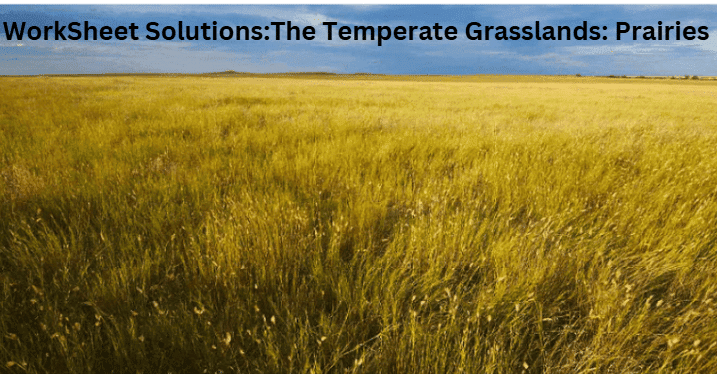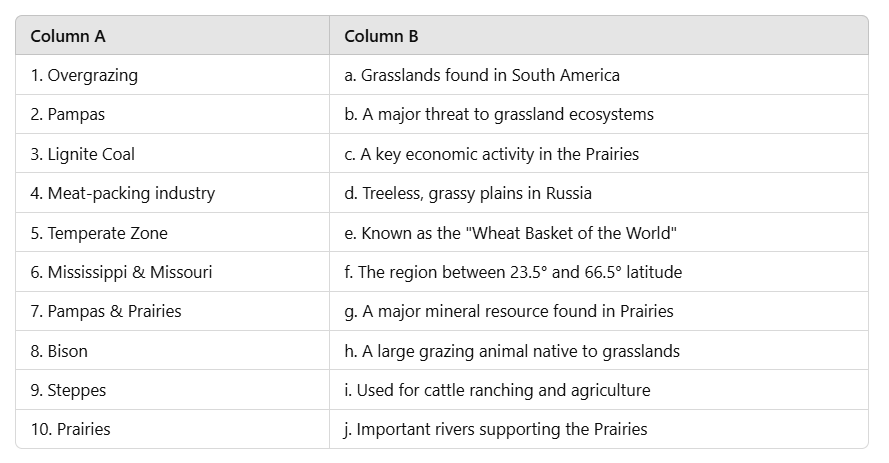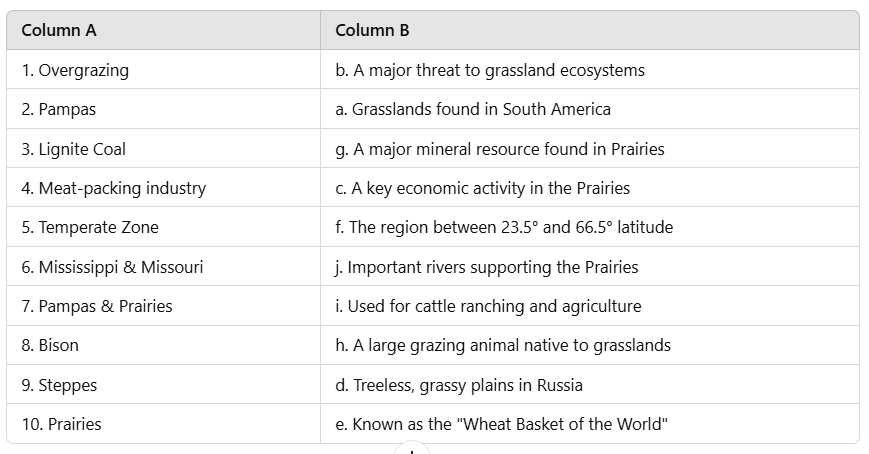The Temperate Grasslands: Prairies - 2 Class 5 Worksheet SST
| Table of contents |

|
| Find the Odd One Out and Give Reason |

|
| Match the Following |

|
| Real-Life Application Based Questions |

|
| True or False |

|

Find the Odd One Out and Give Reason
(i) Prairies, Pampas, Steppes, RainforestAns: Rainforest
Prairies, Pampas, and Steppes are all temperate grasslands, whereas a rainforest is a humid, tree-dense ecosystem found in tropical regions.
(ii) Bison, Elephant, Antelope, Prairie Dog
Ans: Elephant
Bison, Antelope, and Prairie Dogs are native to temperate grasslands, while elephants are typically found in savannas and forests.
(iii) Wheat, Maize, Rice, Barley
Ans: Rice
Wheat, Maize, and Barley are major crops of the grasslands, whereas Rice is mainly grown in wetland or tropical areas.
(iv) Mississippi, Missouri, Amazon, Murray-Darling
Ans: Amazon
The Mississippi, Missouri, and Murray-Darling rivers flow through temperate grassland regions, whereas the Amazon flows through a tropical rainforest.
(v) Ploughing, Threshing, Fishing, Harvesting
Ans: Fishing
Ploughing, Threshing, and Harvesting are common agricultural activities in the grasslands, while Fishing is not relevant to this ecosystem.
Match the Following

Ans: 
Real-Life Application Based Questions
(i) Why are farmers in the Prairies able to produce more wheat than they need?Ans: The Prairies have fertile soil, moderate rainfall, and an extensive use of machinery, allowing large-scale wheat production. This is why they are called the "Wheat Basket of the World."
(ii) Why do many grassland animals like bison and antelope run fast?
Ans: Since grasslands are open with little tree cover, there is no place to hide from predators, so speed is a survival adaptation.
(iii) Why are grasslands in some regions shrinking over time?
Ans: Human activities like farming, urbanization, and overgrazing are reducing natural grassland areas, leading to habitat loss for many species.
(iv) Why is cattle ranching common in the Pampas and Prairies?
Ans: Grasslands provide vast open areas with nutrient-rich grass, making them ideal for grazing livestock like cattle.
(v) Why are there fewer trees in the grasslands compared to forests?
Ans: The climate, frequent fires, and grazing animals prevent trees from growing, allowing grasses to dominate instead.
True or False
(i) Temperate grasslands have extreme climate conditions with hot summers and cold winters.Ans: True
The content states that temperate grasslands have very hot summers and extremely cold winters, sometimes reaching -30°C.
(ii) Grasslands cover more than half of the Earth’s surface.
Ans: False
Grasslands cover about one-fourth (25%) of the Earth's land surface, not more than half.
(iii) The Prairies are also called "The Wheat Basket of the World."
Ans: True
The content states that Prairies produce large amounts of wheat and export it worldwide, earning them this nickname.
(iv) Elephants are the most common large animals in temperate grasslands.
Ans: False
The content states that bison, antelope, and prairie dogs are the dominant animals in the grasslands, not elephants.
(v) The Pampas of South America are mainly used for cattle ranching.
Ans: True
The Pampas are known for large-scale cattle ranching, which is a major economic activity in Argentina and surrounding areas.
(vi) Most farming in the grasslands is done manually without machinery.
Ans: False
The content mentions that farming in the Prairies is highly mechanized, with machines used for ploughing, sowing, and harvesting.
(vii) The Mississippi and Missouri rivers provide irrigation to the Prairies.
Ans: True
The content states that these rivers help in irrigation and support agriculture in the Prairies.
(viii) The Steppes in Russia are known for their dense forests.
Ans: False
The Steppes are treeless grassy plains, not forests.
(ix) Grasslands are home to over 1 billion people.
Ans: True
The content explicitly states that grasslands support the livelihoods of over 1 billion people globally.
(x) Overgrazing and human interference pose threats to grassland ecosystems.
Ans: True
The content mentions that overgrazing, urban development, and invasive species are some of the major threats to grasslands.
|
33 videos|264 docs|50 tests
|
FAQs on The Temperate Grasslands: Prairies - 2 Class 5 Worksheet SST
| 1. What are temperate grasslands and where can they be found? |  |
| 2. What is the climate like in temperate grasslands? |  |
| 3. What types of animals are commonly found in prairies? |  |
| 4. Why are prairies important for the environment? |  |
| 5. What are some threats facing temperate grasslands today? |  |















